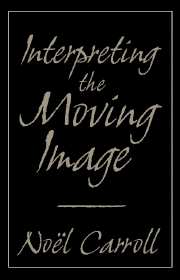Book contents
- Frontmatter
- Contents
- Foreword: Through Carroll's Looking Glass of Criticism
- Introduction
- 1 The Cabinet of Dr. Kracauer
- 2 Entr'acte, Paris and Dada
- 3 The Gold Rush
- 4 Keaton: Film Acting as Action
- 5 Buster Keaton, The General, and Visible Intelligibility
- 6 For God and Country
- 7 Lang, Pabst, and Sound
- 8 Notes on Dreyer's Vampyr
- 9 King Kong: Ape and Essence
- 10 Becky Sharp Takes Over
- 11 Interpreting Citizen Kane
- 12 The Moral Ecology of Melodrama: The Family Plot and Magnificent Obsession
- 13 Mind, Medium, and Metaphor in Harry Smith's Heaven and Earth Magic
- 14 Welles and Kafka
- 15 Nothing But a Man and The Cool World
- 16 Identity and Difference: From Ritual Symbolism to Condensation in Anger's Inauguration of the Pleasure Dome
- 17 Text of Light
- 18 Joan Jonas: Making the Image Visible
- 19 Introduction to Journeys from Berlin/1971
- 20 The Future of Allusion: Hollywood in the Seventies (and Beyond)
- 21 Back to Basics
- 22 Amy Taubin's Bag
- 23 Herzog, Presence, and Paradox
- 24 Film in the Age of Postmodernism
- Notes
- Index
2 - Entr'acte, Paris and Dada
Published online by Cambridge University Press: 05 June 2012
- Frontmatter
- Contents
- Foreword: Through Carroll's Looking Glass of Criticism
- Introduction
- 1 The Cabinet of Dr. Kracauer
- 2 Entr'acte, Paris and Dada
- 3 The Gold Rush
- 4 Keaton: Film Acting as Action
- 5 Buster Keaton, The General, and Visible Intelligibility
- 6 For God and Country
- 7 Lang, Pabst, and Sound
- 8 Notes on Dreyer's Vampyr
- 9 King Kong: Ape and Essence
- 10 Becky Sharp Takes Over
- 11 Interpreting Citizen Kane
- 12 The Moral Ecology of Melodrama: The Family Plot and Magnificent Obsession
- 13 Mind, Medium, and Metaphor in Harry Smith's Heaven and Earth Magic
- 14 Welles and Kafka
- 15 Nothing But a Man and The Cool World
- 16 Identity and Difference: From Ritual Symbolism to Condensation in Anger's Inauguration of the Pleasure Dome
- 17 Text of Light
- 18 Joan Jonas: Making the Image Visible
- 19 Introduction to Journeys from Berlin/1971
- 20 The Future of Allusion: Hollywood in the Seventies (and Beyond)
- 21 Back to Basics
- 22 Amy Taubin's Bag
- 23 Herzog, Presence, and Paradox
- 24 Film in the Age of Postmodernism
- Notes
- Index
Summary
Dada is a form of nihilism. But it would be a mistake to characterize it as a movement without a moral posture. Instead, it is of a piece with the kind of moral immoralism which emerges in the wake of Rousseau and de Sade, and which encompasses, among others, Baudelaire, Rimbaud and Gide. A basic gesture of the moral immoralist is to parade and to celebrate his infamies, outrages, excesses and sins, not in order to titillate, but rather to reveal hypocrisy. Certainly there were immoralists before Rousseau; but the great historical bounders, like Cellini, reveled in their antics to entertain. The moral nihilist presents his crimes in protest against existing morality and culture. He plays the boundary between morality conceived of as customary practice and the notion that there are deeper values that customary practice inhibits. The positive morality of the moral immoralist is often not systematically articulated; his role is generally negative. His gesture, though ostensibly lacking morality (customary morality), still constitutes an essentially moral act, namely that of condemnation.
Dada, significantly, began in reaction to the First World War. It was a protest against the bourgeois culture that caused such destruction. The Dadaist viewed bourgeois culture as an integral whole – art, morality and etiquette each being different faces of the same thing and going by the calling card of rationality. The protest of the Dadaist, consequently, was multi-dimensional, promoting anti-bourgeois art, anti-bourgeois morality and defiant rudeness.
- Type
- Chapter
- Information
- Interpreting the Moving Image , pp. 26 - 33Publisher: Cambridge University PressPrint publication year: 1998

